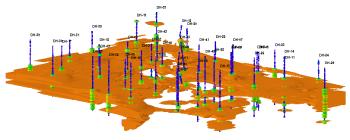

This section of the Borehole Manager tutorial contains lessons for creating diagrams to illustrate downhole data that’s entered into the project’s P-Data tables. P-Data simply refers to downhole samples that are measured at depth points rather than over depth intervals. This is commonly used for geophysical data.
If you have already done the lithology or stratigraphy lessons, some of these procedures will be very much the same. However, rather than illustrating rock types only in logs, the downhole point data will be illustrated as curves or discs in the logs. A solid model will be created to illustrate the isosurface, multi-panel section, and fence diagram.
Pick a lesson by clicking on its arrow. We recommend going through these lessons in the order listed. If you're in a rush, the * lessons are required for lessons further in the sequence.
![]() If this is the first lesson set you’ve done, please be sure you have (1) opened a project folder, (2) restored the program defaults, and (3) set the project dimensions.
If this is the first lesson set you’ve done, please be sure you have (1) opened a project folder, (2) restored the program defaults, and (3) set the project dimensions.
| Tutorial Lesson | Minimum licensing level |
|
| Look at the Point Data layout. * See how the data columns and values are defined, and how to edit the data as a spreadsheet. |
Basic (or Trial) |
|
| Display P-Data logs in 3D. * This offers a quick, overall view of the Gamma measurements data as entered, across the project. |
Basic (or Trial) |
|
| Display P-Data logs in a 2D cross section. * This shows the Gamma and Resistivity measurements for selected boreholes in a multi-log cross section diagram. |
Basic (or Trial) |
|
| Create a P-data isosurface diagram. * Here you will interpolate the log data into a continuous solid model and display it as an isosurface. |
Standard (or Trial) |
|
| Create a P-data multi-panel cross section. Using the interpolated model, you'll display connected slices in a cross section diagram. |
Standard (or Trial) |
|
| Create a P-data fence diagram. Using the interpolated model, you'll display multiple panels in a 3D fence diagram. |
Standard (or Trial) |
"*" lessons are required for subsequent lessons.
![]() Back to main menu
Back to main menu